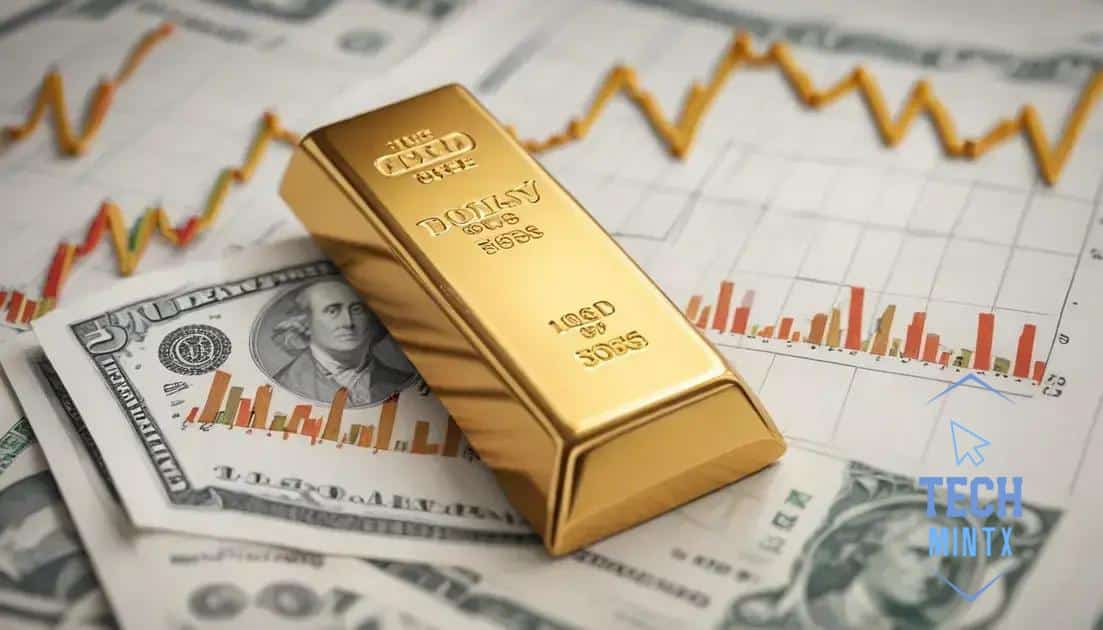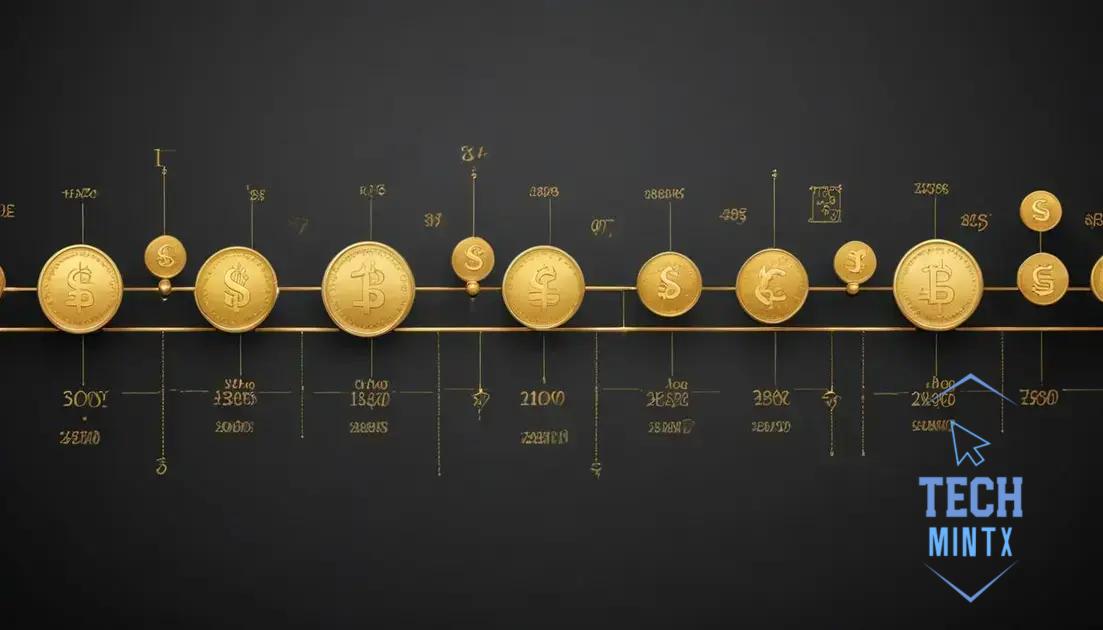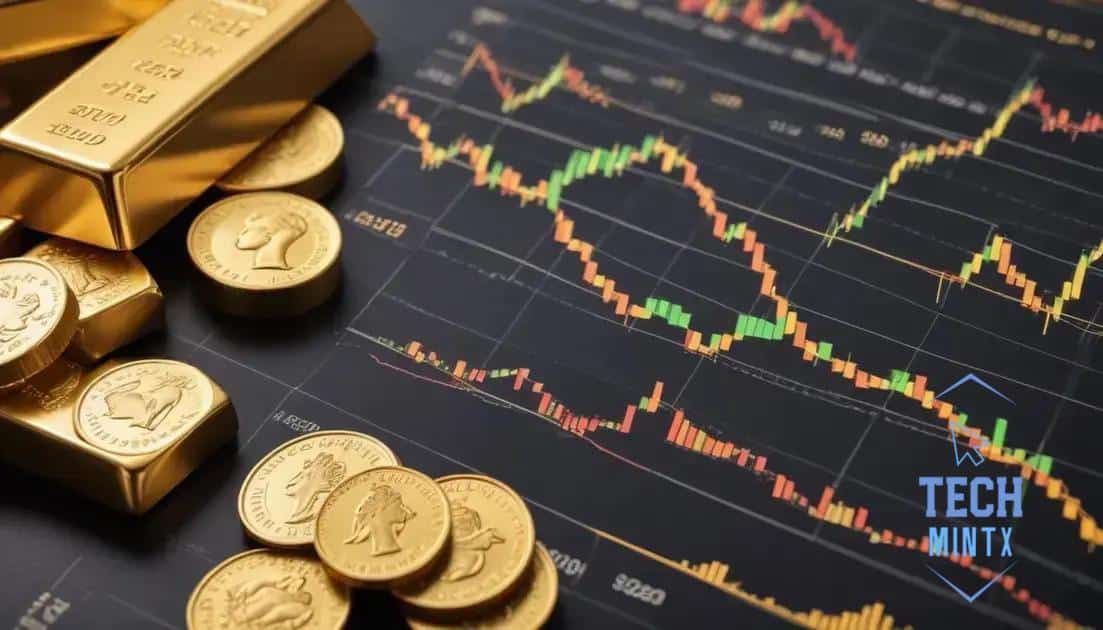Gold demand grows during currency fluctuations

Gold demand grows during currency fluctuations as investors seek stability; it serves as a safe haven and a hedge against inflation, making it a valuable asset in uncertain economic times.
Gold demand grows during currency fluctuations as investors seek stability in uncertain times. Have you noticed how often gold becomes a go-to asset when the economy wavers? Let’s delve into how and why this trend continues to evolve.
Understanding currency fluctuations
Understanding currency fluctuations is essential for investors, especially when considering gold demand. Currency values constantly change due to economic factors, and this can affect how people view gold as an investment.
When a currency weakens, investors often turn to gold. This precious metal is seen as a stable investment during economic uncertainty. People tend to buy gold to protect their savings, which increases its demand. Let’s explore this concept further.
Factors Affecting Currency Fluctuations
Several factors contribute to changes in currency value. Understanding these can help investors predict market movements.
- Interest rates: Higher interest rates offer better returns on investments, increasing demand for that country’s currency.
- Economic stability: A stable economy often leads to a stronger currency.
- Political stability: Countries with stable political conditions generally experience less currency fluctuation.
- Market speculation: Traders’ perceptions can lead to quick shifts in currency values.
As these factors change, they create a ripple effect. For instance, a sudden political crisis can cause a currency to drop in value overnight. Consequently, investors look for safe havens, and gold shines brightly in those moments.
Moreover, currency fluctuations can create opportunities for profit. Savvy investors monitor these changes and may buy gold when prices are low during currency dips. This strategy aims to sell their gold once the market stabilizes.
The Role of Central Banks
Central banks often intervene in currency markets. They buy or sell currencies to influence their values. This can provide temporary relief during turbulent times, impacting how investors react to gold prices.
Overall, understanding how currency fluctuations affect gold demand is crucial. It allows investors to make informed decisions. Observing trends and being aware of market conditions can lead to better investment outcomes.
The historical correlation between gold and currency values

The historical correlation between gold and currency values is fascinating and tells us much about economic stability. Over the years, whenever a currency experiences significant fluctuations, gold prices often react.
For instance, during times of inflation, people typically flock to gold as a safe investment. As the currency loses purchasing power, the demand for gold rises, leading to higher prices. The relationship between gold and currency can help predict market trends.
Past Economic Crises
Analysis of past economic crises reveals a consistent pattern. For example, during the 2008 financial crisis, many investors turned to gold. Prices soared as currencies weakened. This trend is not new; it has occurred throughout history.
- Great Depression: Gold prices rose as the U.S. dollar weakened.
- 1970s Stagflation: Inflation surged, leading to a spike in gold prices.
- 2008 Financial Crisis: Uncertainty caused an influx into gold investments.
Understanding these moments can guide current investors. When currencies are unstable, it often signals a potential rise in gold value. As history shows, those who invest during these times can benefit when the markets stabilize.
Moreover, central banks play a crucial role in this relationship. They maintain significant gold reserves to support their currencies. This practice reflects their belief in the enduring value of gold, especially during economic turmoil. Thus, the more a currency’s value diminishes, the clearer the connection becomes to gold’s rising significance.
Gold as an Economic Indicator
Gold also serves as an economic indicator. Its price movements can mirror the strength or weakness of a currency. When investors anticipate a downturn in a specific currency, gold prices usually react almost immediately. Monitoring these trends allows investors to make informed decisions regarding their portfolios.
In summary, the historical correlation between gold and currency values illustrates how closely tied these two elements are, especially during uncertain times. Staying aware of these patterns can help investors navigate the complexities of the financial market effectively.
Why gold becomes a safe haven during financial instability
During times of financial instability, many investors turn to gold as a safe haven. This trend is rooted in gold’s long-standing reputation as a reliable asset. Unlike paper money, gold holds intrinsic value that remains more stable over time.
When markets dip, fear and uncertainty often grow. Investors begin to sell off riskier assets, leading to drops in stock prices. In these moments, the appeal of gold increases significantly. It provides a sense of security that other investments may not offer.
Psychological Factors
The psychology of investing plays a key role in why gold is sought after during economic downturns. People have an inherent need to feel secure. When they perceive that their investments are at risk, they turn to gold for peace of mind.
- Historical stability: Gold has been valued for centuries, making it feel like a safer choice.
- Limited supply: Gold is finite, which can boost its value during uncertain times.
- Wealth preservation: Investors believe gold can protect their wealth against inflation.
Furthermore, geopolitical tensions can trigger a rush to gold. Events such as wars, political unrest, or trade disputes often lead people to purchase gold to safeguard their wealth. This is because gold tends to retain its value when other assets struggle.
The Role of Inflation
Inflation is another crucial factor that drives people to seek gold. When the cost of living rises, currencies lose purchasing power. In such cases, gold can act as a hedge against inflation. This relationship explains why gold prices often surge during periods of high inflation.
In short, the reasons why gold becomes a safe haven during financial instability include its intrinsic value, psychological comfort, and historical significance. Investors look to it as a way to secure their finances when uncertainty looms.
Diverse investment strategies involving gold

Diverse investment strategies involving gold can provide investors with a robust way to navigate market uncertainties. Gold is not only a physical asset but also a versatile tool for various investment approaches. As economic conditions fluctuate, having a strategic plan can lead to significant returns.
One popular method is to buy physical gold. This includes gold bars, coins, and jewelry. Investors often view physical gold as a long-term store of value, offering security in times of crisis. However, storing physical gold safely can involve additional costs.
Gold ETFs and Mutual Funds
Another strategy is to invest in gold exchange-traded funds (ETFs) or mutual funds that focus on gold mining companies. These financial products allow investors to gain exposure to gold without needing to handle physical assets. They can be traded like stocks, providing liquidity.
- Gold ETFs track the price of gold.
- Gold mining funds invest in companies involved in gold extraction.
- Both options offer diversification benefits.
Additionally, some investors choose to use futures contracts to invest in gold. This approach allows individuals to speculate on the price of gold at a future date. While it can lead to substantial profits, it’s also associated with high risk. Therefore, careful research and risk management are essential.
Diversification Benefits
Incorporating gold into an investment portfolio offers diversification benefits. Gold often behaves differently than stocks and bonds. When other investments decline, gold can increase in value, cushioning losses. This characteristic makes it a suitable hedge against inflation.
Furthermore, considering a phased investment approach can be effective. This strategy involves gradually purchasing gold over time instead of making a lump-sum investment. By doing this, investors can average their costs and reduce the impact of price volatility.
Overall, utilizing diverse investment strategies involving gold can enhance a portfolio’s resilience and potential for growth. Whether through physical ownership, ETFs, mutual funds, or futures contracts, each strategy has unique benefits that align with different investor goals.
Future outlook for gold in a changing economy
The future outlook for gold in a changing economy remains an area of keen interest for investors and analysts alike. As global markets evolve, several factors will influence gold’s role as a valuable asset. Understanding these trends can help investors make informed decisions.
One crucial factor is the changing dynamics of inflation. As central banks adjust interest rates in response to economic shifts, inflation can rise or fall rapidly. When inflation rates spike, gold often becomes more attractive. Investors seek gold to shield their wealth from decreasing purchasing power.
Global Political Climate
The global political climate significantly affects gold demand. Events such as geopolitical tensions, trade wars, or changes in government policies may cause uncertainty in financial markets, leading to a surge in gold purchases.
- Geopolitical tensions can increase demand for gold as a safe-haven asset.
- Trade disputes may cause market volatility, making gold more appealing.
- Changes in trade agreements can influence currency values, impacting gold prices.
Additionally, technological advancements and changing consumer preferences may shape the future of gold. The rise of digital currencies and alternative investments could either complement or challenge gold’s traditional status.
Market Sentiment and Speculation
Market sentiment plays a vital role in gold’s price movement. When economic outlooks waver, fear among investors often pushes gold prices higher. Speculators may drive price fluctuations based on their expectations of future trends.
Another aspect to consider is the mining sector. As more sustainable and responsible mining practices emerge, the supply of gold could stabilize, impacting prices. The balance between supply and demand remains essential in predicting future gold trends.
Therefore, the outlook for gold in a changing economy appears positive, driven by continued demand as a hedge against economic uncertainty, inflation, and market volatility. Investors should stay abreast of global developments and market trends to make the best decisions regarding their gold investments.
In conclusion, gold remains a valuable asset and a strong investment option, especially during times of financial instability. Its historical significance and stability make it a go-to safe haven for investors. The future outlook for gold is promising, driven by market demand, inflation concerns, and global political dynamics.
By understanding diverse investment strategies involving gold, individuals can position themselves to benefit from its enduring value. Staying informed about market trends is essential for maximizing investment potential in this precious metal.
FAQ – Frequently Asked Questions about Gold Investment
Why should I invest in gold?
Investing in gold provides a safe haven during economic uncertainty and protects against inflation.
What are the different ways to invest in gold?
You can invest in physical gold, gold ETFs, mutual funds, or futures contracts.
How does geopolitical tension affect gold prices?
Geopolitical tensions often lead to increased demand for gold as a safe asset, driving its prices higher.
Is it a good time to invest in gold now?
Market conditions and inflation rates suggest it may be a strong time to consider gold investment.





